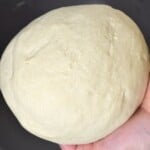Easy Arabic Bread Dough (Manakish Dough)
This Middle Eastern bread dough (Arabic bread dough) is a quick, easy, and versatile all-purpose dough - Perfect for pizza, calzone, fatayer, manakish, lahmebajen, etc. All you need is just 4 ingredients for the base to tons of Middle-Eastern bread and pastry recipes!
Servings: 8 medium-sized breads (more/less depending on size)
Ingredients
- 1 cup lukewarm water
- 1 Tbsp sugar
- 2 tsp active dry yeast 7 grams (or 25% less instant yeast powder)
- 3 cups plain all-purpose flour
- 1 tsp salt
- 1/3 cup plain yogurt or plant-based yogurt - optional (can replace this with neutral oil)
Instructions
Step 1: Activate the yeast
- Add the water, sugar, and yeast to a small bowl, mix well and then allow it to stand for between 5-10 minutes for the yeast to activate. It should froth up and become quite bubbly during this time.Meanwhile, combine the sifted flour and salt in a large bowl.
Step 2: Mix and knead the dough
- Add the yeast mixture and yogurt to the bowl, mix into a rough dough, and then knead for around 10 minutes until you have a smooth, elastic dough. When poked with a finger, the dough should bounce back again - if it doesn't, knead it a little longer.The dough should be smooth and not sticky. If it’s a little sticky, then add an extra tablespoon of flour at a time. Likewise, if it’s too dry (crumbly), then add a tablespoon of water and then knead until you have a smooth texture.
- Knead the dough by hand, or use a stand mixer (which usually takes a couple of minutes less). You could also use a food processor with a dough blade, but this usually takes quite a lot less time due to the faster speed. Check after two minutes, then every 20-30 seconds after.
Step 3: Proof the dough
- Form the dough into a rough ball and cover lightly with oil, then place back in the bowl.Cover the bowl with a kitchen towel or cling film and place it in a warm place to prove for between 45 minutes to an hour. During this time, it should double in size.
- If it's particularly cold on that day/where you are, then it may be best to turn the oven on its lowest temperature for 5-10 minutes, switch it off then allow the dough to rest in the switched-off oven.
Step 4: Use the Middle Eastern bread dough
- At this point, you're ready to use it for whatever recipe you'd please, which will affect your next step (i.e., how big, what shape, etc., the dough you use will be).
To use as Manakish (Manakeesh)
- I was making manakish, so I used an inverted oven tray (a pizza stone will also work) in the oven at its' highest temperature (for me, that's 500ºF/260ºC).
- For manakish (manakeesh), I divided the dough into 5 balls (you can weigh it for exact pieces, but I did it by eye) to achieve bigger flatbreads (you can also make 8 medium-sized ones). Roll the dough out to around 1/4-inch thickness and shape into either circles or oblong shapes.
- Press your fingers into the dough all over the surface. This will create more space for toppings and will prevent the dough from puffing up too much in the oven.Then top with your toppings of choice - like this za'atar manakish or cheese manakish.
- Carefully transfer the Arabic bread dough to the inverted tray/pizza stone and bake for between 5-6 minutes until it's lightly browned on the edges and underneath.
- Remove it from the oven and cool slightly before wrapping/covering it with a kitchen towel to keep the bread soft.
To Make Ahead & Store
- Mahe ahead: If you don't plan on using all the Middle Eastern bread dough at once time, you can store the prepared dough, wrapped tightly in plastic wrap, for up to 2 days.Store: The freshly baked bread can also be store in an airtight container or the fridge for up to five days. Enjoy at room temperature or warmed.Freezer: The baked bread (like manakish) is freezer-friendly for up to three months. Depending on how you use the dough and what fillings/toppings you use with it, this time may vary.Reheat: You can reheat the baked Middle Eastern flatbread from frozen in the oven at 250ºF/120ºC until warmed through (20-25 minutes usually). If heating from chilled or room temperature, then reduce the time in the oven.
Notes
- For even softer, richer dough, you can add 1-2tsp dry milk powder.
- Feel free to season the dough as preferred depending on the recipe; Italian seasoning, za'atar, garlic, and onion powder, etc.
- To use instant yeast instead of active dry yeast, reduce the amount by 25%
- Why is yogurt added to the dough? When adding yogurt to the dough, it will yield softer, fluffier results. This is because the yogurt's acidity relaxes the gluten for more tender results- without the use of fat like butter/ oil.
- Why is my dough not rising? The most likely culprit is expired yeast. Alternatively, you may have killed the yeast if you use water that is too hot.
Nutrition
Serving: 1Bread | Calories: 192kcal | Carbohydrates: 39g | Protein: 6g | Fat: 1g | Saturated Fat: 1g | Cholesterol: 1mg | Sodium: 299mg | Potassium: 95mg | Fiber: 2g | Sugar: 2g | Vitamin A: 10IU | Vitamin C: 1mg | Calcium: 21mg | Iron: 2mg
